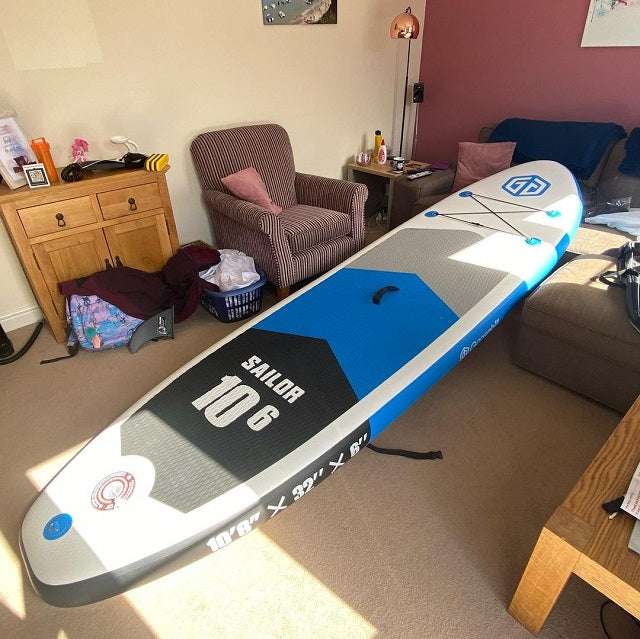8 Things You Should Keep In Mind For Your Inflatable SUP
Table of contents
1. Don't leave your baord dirty
2. Don't leave your board under direct sunlight when not in use
3. Don't store your board incorrectly
4. Don't drag your board
5. Don't transport your board without a bag
6. Don't paddle in shallow water
7. Don't forget your fins
8. Don't assume everyone knows how to use a paddle board correctly
8 Things You Shouldn't Do With Your SUP
You can do a lot of things with your inflatable paddle board like touring, fishing, yoga, etc. but there are a few things that you should not do if you want your paddle board to last longer.
1. Don’t Leave Your Board Dirty
We would suggest that you clean your board after each outing, especially if you’ve spent the day in salt water.
Once you come back from your paddling session, rinse your board with freshwater and then dry it completely with a towel. This is to clean off anything that may damage or stain the board if left on.
2. Don’t leave your board under direct sunlight when not in use
Direct sunlight won’t damage your board instantly, but storing your board in direct sunlight for long periods of time will lead to deterioration in the long run and shorten the lifespan of your board. UV radiation will damage the PVC material when exposed repeatedly day after day.

3. Don’t store your board incorrectly
it's important to find the right place to store your inflatable SUP board after using it for a whole day. The ideal place to store your paddleboard would be somewhere that won’t be affected by weather and temperature changes.
Just keeping your board out of direct sunlight isn’t enough to protect it. What’s great about inflatables is that they are much eaiser to store indoors in a garage or basement that’s less exposed to dramatic temperature changes. We recently wrote an practical article about how to store a paddle board. For a comprehensive overview of paddle storage tips, check out this article.

4. Don’t drag your board
If you think this is obvious, then you are one of the few people who really knows how to protect your board, good for you. But you’ll see a lot of people dragging their boards, especially on the beach. It’s understandable given the large size of an inflatable board. But taking this shortcut might cause your board to be damaged.

You don’t want to drag your board in and out of the water as it would easily scratch and scuff your board. You might think smooth sand and soft grass won’t be able to damage your board, but there might be other small objects you can’t see that can possibly scratch your board. If you don’t want to carry your board for long distances, opt for a board that comes with a roller backpack, or get one of those paddle board carts.
5. Don’t transport your board without a bag
Simply putting your board in the trunk is similiar to dragging your board, you don’t know if there’s any other hazards that could possibly leave a mark on your board.
A bag will be like a shell that can protect your board from most of the unseen potential damages or accidental bumps and bruises that can occur when moving something. No matter how gentle and cautious you are when handling the board, it will be out of your control when it’s in the trunk during transport.

6. Don’t paddle in shallow water
Paddling in shallow water can be dangerous. So try to avoid shallow water if possible. If it’s inevitable, you should be extra careful. No matter where you paddle, you should constantly be aware of the area you’re in.
Paddling in shallow water might result in scratches that comes from whatever objects that lie beneath. You don’t want to risk damaging your board during a leisure paddling session. So stay away from shallow water if that’s an option.

7. Don’t forget your fins
Due to their position on the underside of the board, fins can be easily damaged when paddling in shallow water. If the fins, especially the large center fin, are damaged, it will have a negative effect on the performance of your board.
Inflatable boards usually use two types of fin system, slide-in fin box and the US fin box, both are easy to operate. Even if your board uses the more complicated US fin box, you can install and remove the fin within 20 seconds. So we would suggest taking it off during transport and before storing them.
Also, choose a paddling location that has deep enough water so that the large fin is able to clear the bottom.

8. Don’t assume everyone knows how to use a paddle board correctly
Paddle boarding is like board games, it’s more fun if you can get more people to join you. There will be times when you loan your board to friends or family. Usually one to two trips is enough for them to fall in love with paddle boarding and to get them on the water with you.
Since you are moe experienced in the sport, it would be of great help to them if you can share what you know with them. It will help prevent them from making some simple mistakes and in a way, protect your board when it’s borrowed.

Conclusion
Knowing what not to do with your board can help prolong the lifespan of your board. They are not that hard, don’t let those Don’ts stop you from having fun with your board. It’s one of the most fun water sports and you should definitely do it more.











Leave a comment